外研版年级下册 Module 9 Friendship 模块表格式教案
文档属性
| 名称 | 外研版年级下册 Module 9 Friendship 模块表格式教案 | 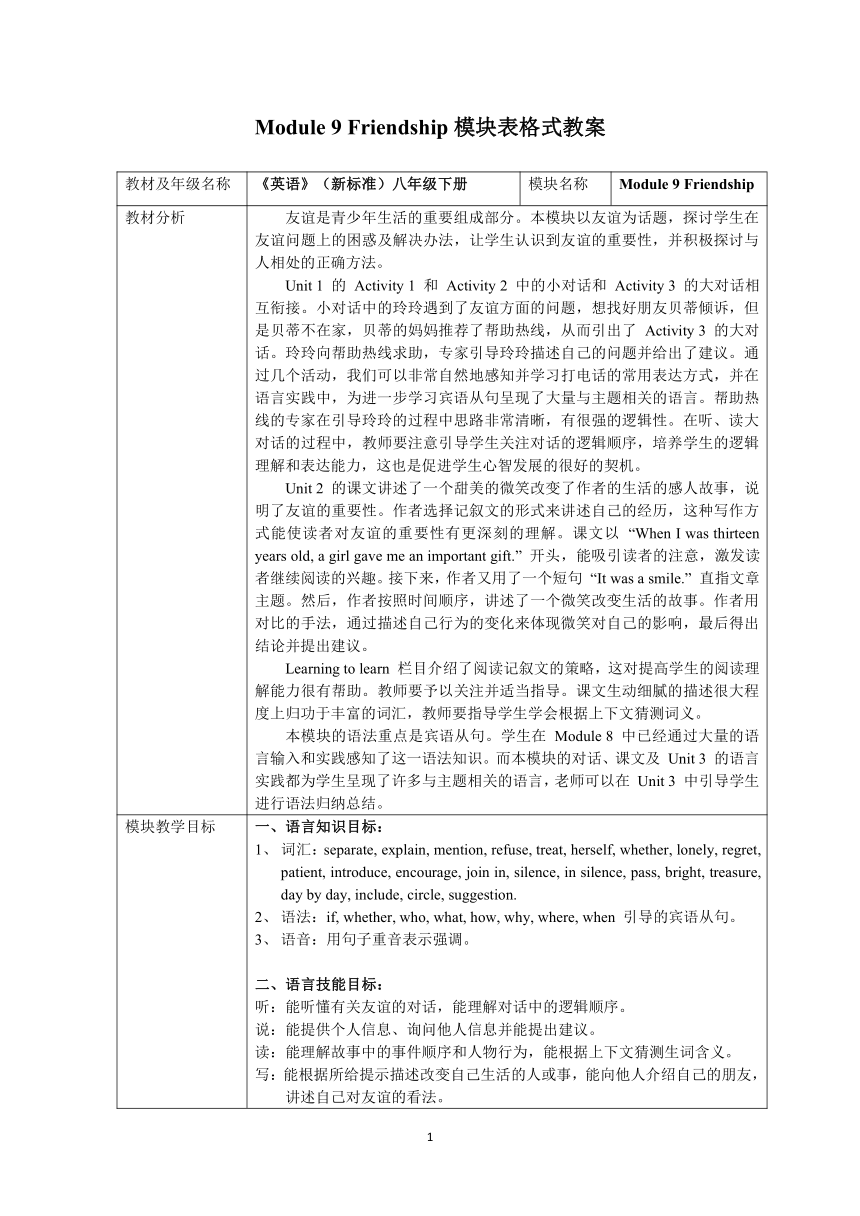 | |
| 格式 | doc | ||
| 文件大小 | 124.0KB | ||
| 资源类型 | 教案 | ||
| 版本资源 | 外研版 | ||
| 科目 | 英语 | ||
| 更新时间 | 2023-01-02 20:26:48 | ||
图片预览

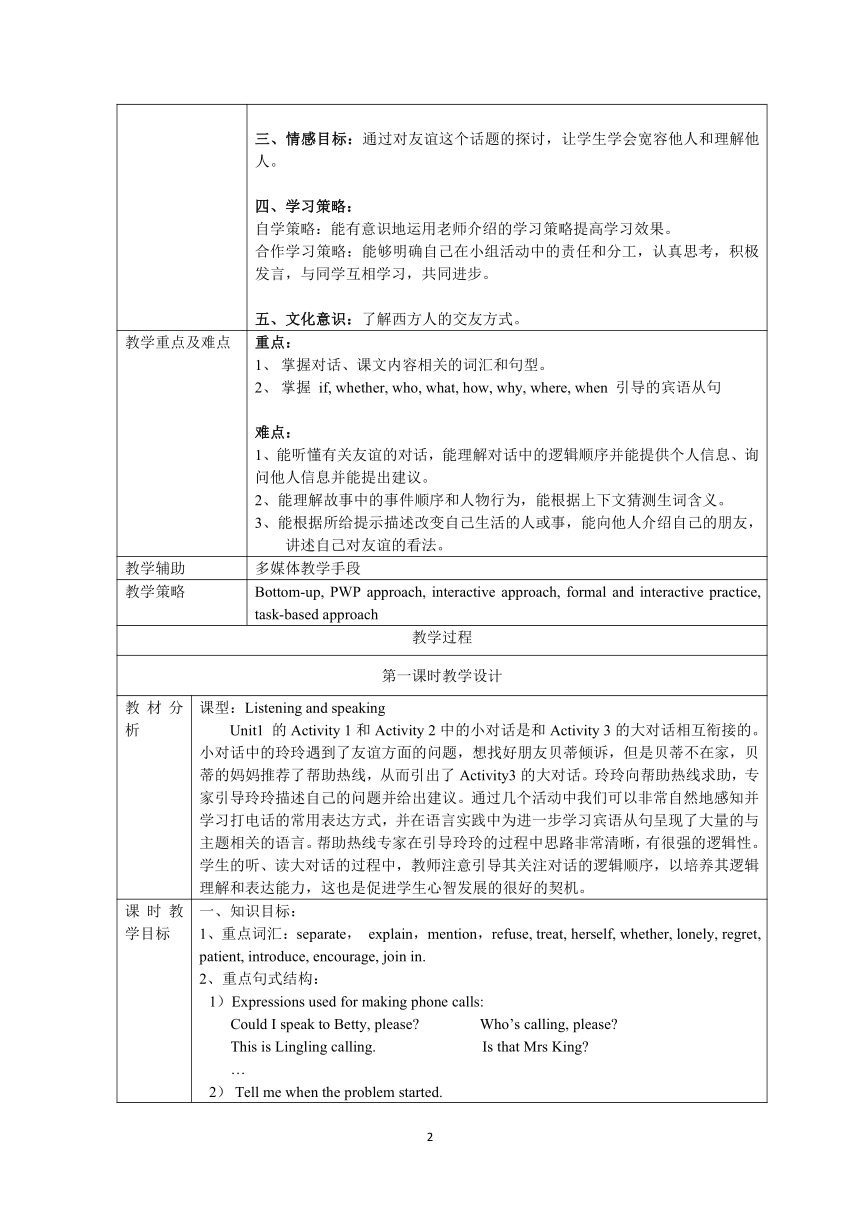
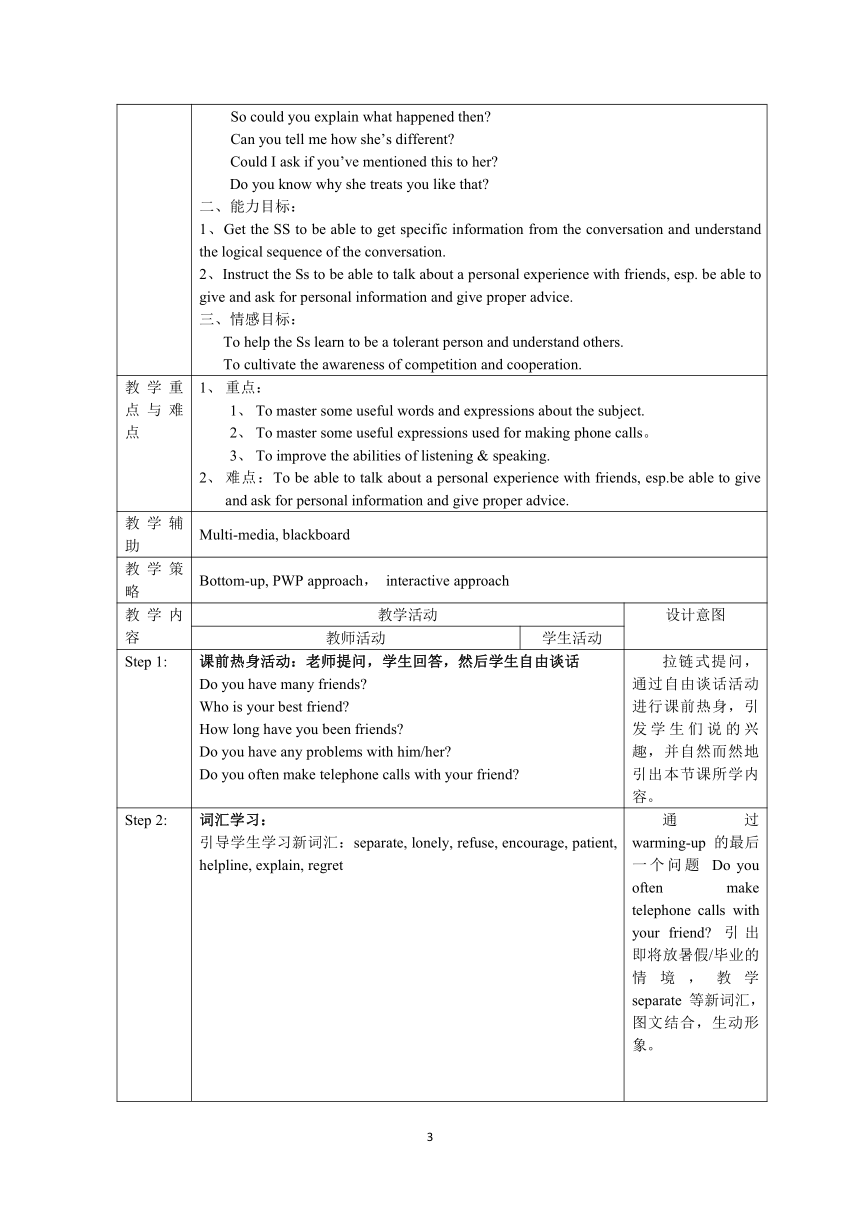
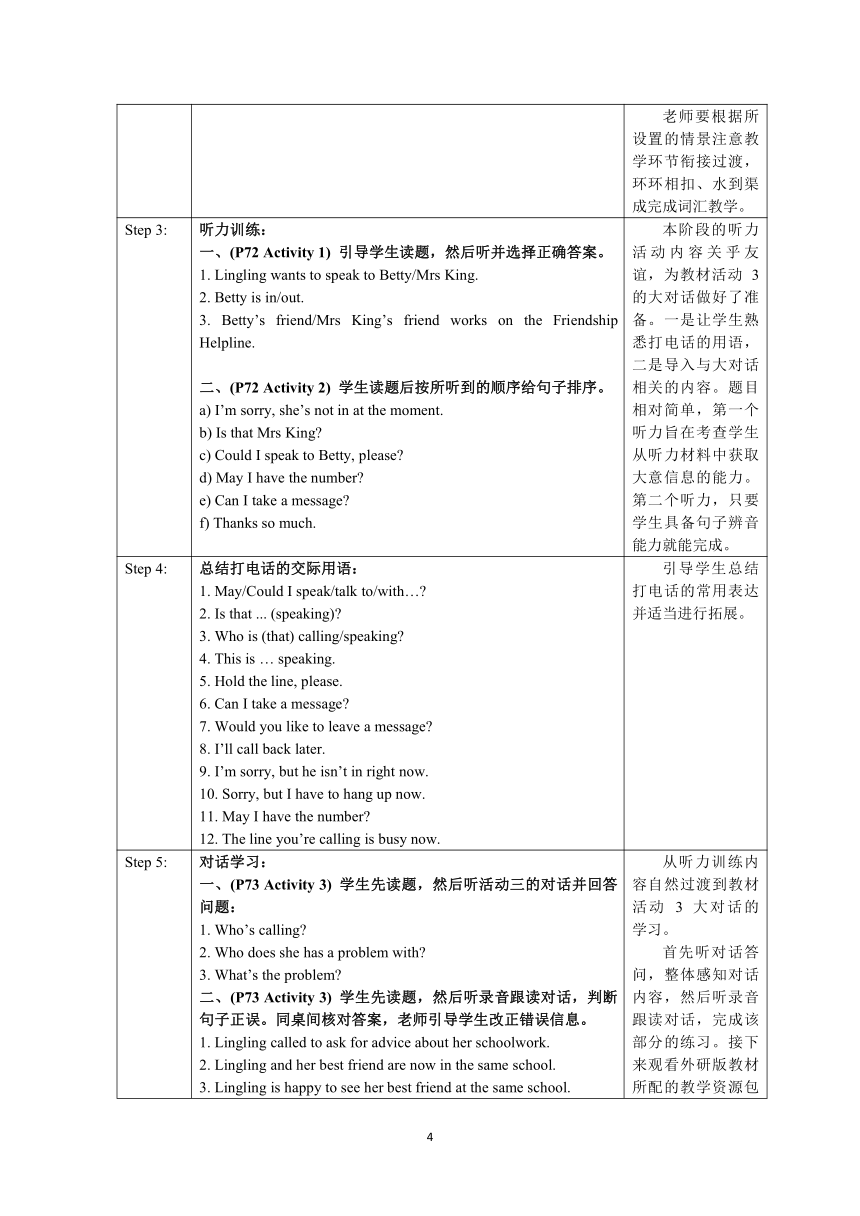
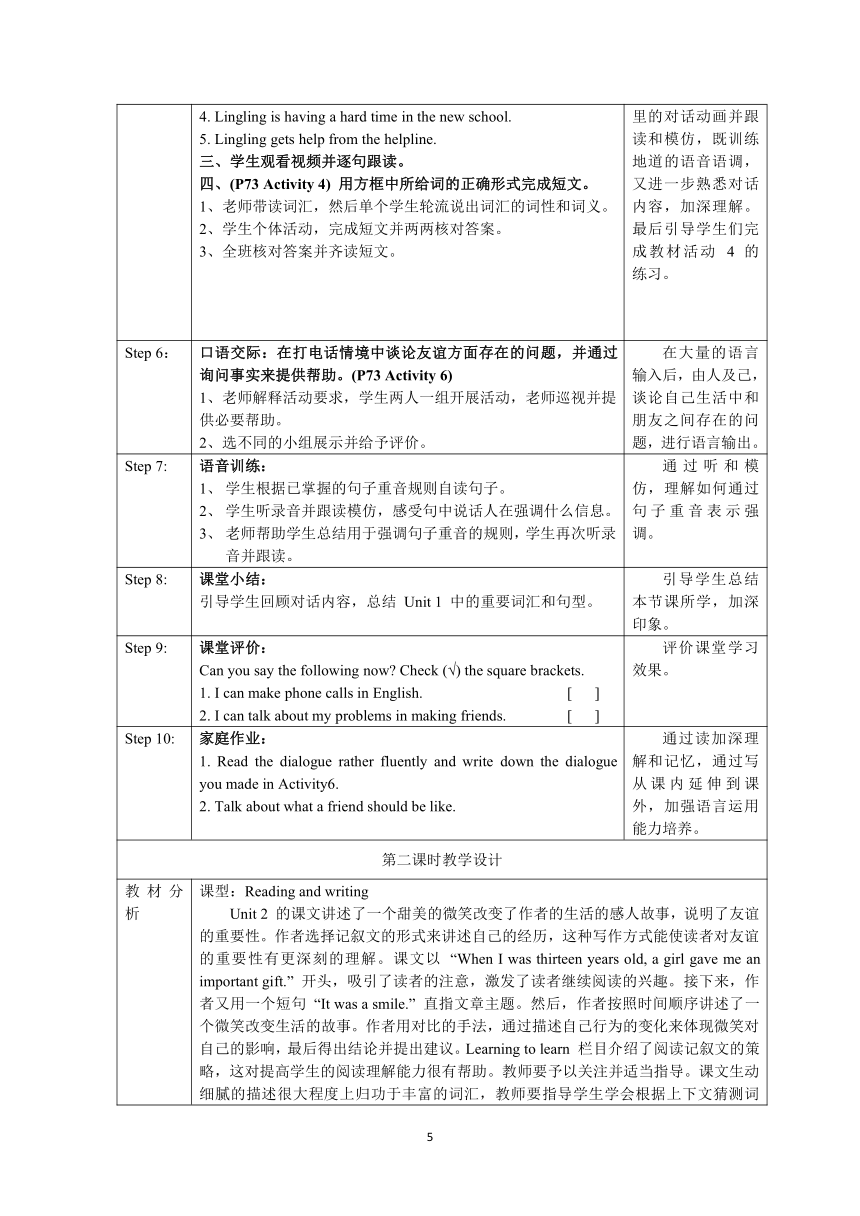
文档简介
Module 9 Friendship模块表格式教案
教材及年级名称 《英语》(新标准)八年级下册 模块名称 Module 9 Friendship
教材分析 友谊是青少年生活的重要组成部分。本模块以友谊为话题,探讨学生在友谊问题上的困惑及解决办法,让学生认识到友谊的重要性,并积极探讨与人相处的正确方法。Unit 1 的 Activity 1 和 Activity 2 中的小对话和 Activity 3 的大对话相互衔接。小对话中的玲玲遇到了友谊方面的问题,想找好朋友贝蒂倾诉,但是贝蒂不在家,贝蒂的妈妈推荐了帮助热线,从而引出了 Activity 3 的大对话。玲玲向帮助热线求助,专家引导玲玲描述自己的问题并给出了建议。通过几个活动,我们可以非常自然地感知并学习打电话的常用表达方式,并在语言实践中,为进一步学习宾语从句呈现了大量与主题相关的语言。帮助热线的专家在引导玲玲的过程中思路非常清晰,有很强的逻辑性。在听、读大对话的过程中,教师要注意引导学生关注对话的逻辑顺序,培养学生的逻辑理解和表达能力,这也是促进学生心智发展的很好的契机。Unit 2 的课文讲述了一个甜美的微笑改变了作者的生活的感人故事,说明了友谊的重要性。作者选择记叙文的形式来讲述自己的经历,这种写作方式能使读者对友谊的重要性有更深刻的理解。课文以 “When I was thirteen years old, a girl gave me an important gift.” 开头,能吸引读者的注意,激发读者继续阅读的兴趣。接下来,作者又用了一个短句 “It was a smile.” 直指文章主题。然后,作者按照时间顺序,讲述了一个微笑改变生活的故事。作者用对比的手法,通过描述自己行为的变化来体现微笑对自己的影响,最后得出结论并提出建议。Learning to learn 栏目介绍了阅读记叙文的策略,这对提高学生的阅读理解能力很有帮助。教师要予以关注并适当指导。课文生动细腻的描述很大程度上归功于丰富的词汇,教师要指导学生学会根据上下文猜测词义。本模块的语法重点是宾语从句。学生在 Module 8 中已经通过大量的语言输入和实践感知了这一语法知识。而本模块的对话、课文及 Unit 3 的语言实践都为学生呈现了许多与主题相关的语言,老师可以在 Unit 3 中引导学生进行语法归纳总结。
模块教学目标 一、语言知识目标:词汇:separate, explain, mention, refuse, treat, herself, whether, lonely, regret, patient, introduce, encourage, join in, silence, in silence, pass, bright, treasure, day by day, include, circle, suggestion.语法:if, whether, who, what, how, why, where, when 引导的宾语从句。语音:用句子重音表示强调。二、语言技能目标:听:能听懂有关友谊的对话,能理解对话中的逻辑顺序。说:能提供个人信息、询问他人信息并能提出建议。读:能理解故事中的事件顺序和人物行为,能根据上下文猜测生词含义。写:能根据所给提示描述改变自己生活的人或事,能向他人介绍自己的朋友,讲述自己对友谊的看法。三、情感目标:通过对友谊这个话题的探讨,让学生学会宽容他人和理解他人。四、学习策略:自学策略:能有意识地运用老师介绍的学习策略提高学习效果。合作学习策略:能够明确自己在小组活动中的责任和分工,认真思考,积极发言,与同学互相学习,共同进步。五、文化意识:了解西方人的交友方式。
教学重点及难点 重点:掌握对话、课文内容相关的词汇和句型。掌握 if, whether, who, what, how, why, where, when 引导的宾语从句难点:1、能听懂有关友谊的对话,能理解对话中的逻辑顺序并能提供个人信息、询问他人信息并能提出建议。2、能理解故事中的事件顺序和人物行为,能根据上下文猜测生词含义。3、能根据所给提示描述改变自己生活的人或事,能向他人介绍自己的朋友,讲述自己对友谊的看法。
教学辅助 多媒体教学手段
教学策略 Bottom-up, PWP approach, interactive approach, formal and interactive practice, task-based approach
教学过程
第一课时教学设计
教材分析 课型:Listening and speakingUnit1 的Activity 1和Activity 2中的小对话是和Activity 3的大对话相互衔接的。小对话中的玲玲遇到了友谊方面的问题,想找好朋友贝蒂倾诉,但是贝蒂不在家,贝蒂的妈妈推荐了帮助热线,从而引出了Activity3的大对话。玲玲向帮助热线求助,专家引导玲玲描述自己的问题并给出建议。通过几个活动中我们可以非常自然地感知并学习打电话的常用表达方式,并在语言实践中为进一步学习宾语从句呈现了大量的与主题相关的语言。帮助热线专家在引导玲玲的过程中思路非常清晰,有很强的逻辑性。学生的听、读大对话的过程中,教师注意引导其关注对话的逻辑顺序,以培养其逻辑理解和表达能力,这也是促进学生心智发展的很好的契机。
课时教学目标 一、知识目标:1、重点词汇:separate, explain,mention,refuse, treat, herself, whether, lonely, regret, patient, introduce, encourage, join in. 2、重点句式结构: 1)Expressions used for making phone calls: Could I speak to Betty, please Who’s calling, please This is Lingling calling. Is that Mrs King …Tell me when the problem started.So could you explain what happened then Can you tell me how she’s different Could I ask if you’ve mentioned this to her Do you know why she treats you like that 二、能力目标:1、Get the SS to be able to get specific information from the conversation and understand the logical sequence of the conversation.2、Instruct the Ss to be able to talk about a personal experience with friends, esp. be able to give and ask for personal information and give proper advice.三、情感目标: To help the Ss learn to be a tolerant person and understand others.To cultivate the awareness of competition and cooperation.
教学重点与难点 重点:To master some useful words and expressions about the subject.To master some useful expressions used for making phone calls。To improve the abilities of listening & speaking.难点:To be able to talk about a personal experience with friends, esp.be able to give and ask for personal information and give proper advice.
教学辅助 Multi-media, blackboard
教学策略 Bottom-up, PWP approach, interactive approach
教学内容 教学活动 设计意图
教师活动 学生活动
Step 1: 课前热身活动:老师提问,学生回答,然后学生自由谈话Do you have many friends Who is your best friend How long have you been friends Do you have any problems with him/her Do you often make telephone calls with your friend 拉链式提问,通过自由谈话活动进行课前热身,引发学生们说的兴趣,并自然而然地引出本节课所学内容。
Step 2: 词汇学习:引导学生学习新词汇:separate, lonely, refuse, encourage, patient, helpline, explain, regret 通过 warming-up 的最后一个问题 Do you often make telephone calls with your friend 引出即将放暑假/毕业的情境,教学 separate 等新词汇,图文结合,生动形象。老师要根据所设置的情景注意教学环节衔接过渡,环环相扣、水到渠成完成词汇教学。
Step 3: 听力训练:一、(P72 Activity 1) 引导学生读题,然后听并选择正确答案。1. Lingling wants to speak to Betty/Mrs King.2. Betty is in/out.3. Betty’s friend/Mrs King’s friend works on the Friendship Helpline.二、(P72 Activity 2) 学生读题后按所听到的顺序给句子排序。a) I’m sorry, she’s not in at the moment.b) Is that Mrs King c) Could I speak to Betty, please d) May I have the number e) Can I take a message f) Thanks so much. 本阶段的听力活动内容关乎友谊,为教材活动 3 的大对话做好了准备。一是让学生熟悉打电话的用语,二是导入与大对话相关的内容。题目相对简单,第一个听力旨在考查学生从听力材料中获取大意信息的能力。第二个听力,只要学生具备句子辨音能力就能完成。
Step 4: 总结打电话的交际用语:1. May/Could I speak/talk to/with… 2. Is that ... (speaking) 3. Who is (that) calling/speaking 4. This is … speaking. 5. Hold the line, please.6. Can I take a message 7. Would you like to leave a message 8. I’ll call back later.9. I’m sorry, but he isn’t in right now.10. Sorry, but I have to hang up now.11. May I have the number 12. The line you’re calling is busy now. 引导学生总结打电话的常用表达并适当进行拓展。
Step 5: 对话学习:一、(P73 Activity 3) 学生先读题,然后听活动三的对话并回答问题:1. Who’s calling 2. Who does she has a problem with 3. What’s the problem 二、(P73 Activity 3) 学生先读题,然后听录音跟读对话,判断句子正误。同桌间核对答案,老师引导学生改正错误信息。1. Lingling called to ask for advice about her schoolwork.2. Lingling and her best friend are now in the same school.3. Lingling is happy to see her best friend at the same school.4. Lingling is having a hard time in the new school.5. Lingling gets help from the helpline.三、学生观看视频并逐句跟读。四、(P73 Activity 4) 用方框中所给词的正确形式完成短文。1、老师带读词汇,然后单个学生轮流说出词汇的词性和词义。2、学生个体活动,完成短文并两两核对答案。3、全班核对答案并齐读短文。 从听力训练内容自然过渡到教材活动 3 大对话的学习。首先听对话答问,整体感知对话内容,然后听录音跟读对话,完成该部分的练习。接下来观看外研版教材所配的教学资源包里的对话动画并跟读和模仿,既训练地道的语音语调,又进一步熟悉对话内容,加深理解。最后引导学生们完成教材活动 4 的练习。
Step 6: 口语交际:在打电话情境中谈论友谊方面存在的问题,并通过询问事实来提供帮助。(P73 Activity 6)1、老师解释活动要求,学生两人一组开展活动,老师巡视并提供必要帮助。2、选不同的小组展示并给予评价。 在大量的语言输入后,由人及己,谈论自己生活中和朋友之间存在的问题,进行语言输出。
Step 7: 语音训练:学生根据已掌握的句子重音规则自读句子。学生听录音并跟读模仿,感受句中说话人在强调什么信息。老师帮助学生总结用于强调句子重音的规则,学生再次听录音并跟读。 通过听和模仿,理解如何通过句子重音表示强调。
Step 8: 课堂小结:引导学生回顾对话内容,总结 Unit 1 中的重要词汇和句型。 引导学生总结本节课所学,加深印象。
Step 9: 课堂评价:Can you say the following now Check (√) the square brackets.1. I can make phone calls in English. [ ]2. I can talk about my problems in making friends. [ ] 评价课堂学习效果。
Step 10: 家庭作业:1. Read the dialogue rather fluently and write down the dialogue you made in Activity6.2. Talk about what a friend should be like. 通过读加深理解和记忆,通过写从课内延伸到课外,加强语言运用能力培养。
第二课时教学设计
教材分析 课型:Reading and writingUnit 2 的课文讲述了一个甜美的微笑改变了作者的生活的感人故事,说明了友谊的重要性。作者选择记叙文的形式来讲述自己的经历,这种写作方式能使读者对友谊的重要性有更深刻的理解。课文以 “When I was thirteen years old, a girl gave me an important gift.” 开头,吸引了读者的注意,激发了读者继续阅读的兴趣。接下来,作者又用一个短句 “It was a smile.” 直指文章主题。然后,作者按照时间顺序讲述了一个微笑改变生活的故事。作者用对比的手法,通过描述自己行为的变化来体现微笑对自己的影响,最后得出结论并提出建议。Learning to learn 栏目介绍了阅读记叙文的策略,这对提高学生的阅读理解能力很有帮助。教师要予以关注并适当指导。课文生动细腻的描述很大程度上归功于丰富的词汇,教师要指导学生学会根据上下文猜测词义。
课时教学目标 一、知识目标:1、重点词汇:lonely, silence, bright, day by day, trust, include, circle, suggestion.2、重点句式:I did not know who she was.I asked her why she smiled at me that day.She said she could not remember.Now I believe that the world is what you think it is.二、能力目标:1、To understand the sequence of events and the behaviours of characters.2、To be able to guess the meaning of new words from the context.三、情感目标:1、To help the Ss learn to be a tolerant person and understand others.2、To cultivate the awareness of competition and cooperation.
教学重点与难点 重点:To master some useful words and expressions about the subject.To understand the sequence of events and the behaviour of characters and improve the reading ability.To guess the meaning of new words from the context难点:To describe the person or thing that changed your life according to the given information.To introduce your friend to others and express your opinion about friendship.
教学辅助 多媒体、黑板
教学策略 PWP approach
教学内容 教学活动 设计意图
教师活动 学生活动
Step 1: 阅读前活动:1、头脑风暴:What should a good friend be like I think that a good friend should be…2、(P74 Activity 1) 两人合作,提问并回答。1) How do you feel when you are with your friends 2) When was the last time you feel sad 3) Who did you tell that you were sad 4) What did you do to feel better 5) How can you make other people feel happy 阅读前热身活动既是对课前作业的检查,唤醒学生的词汇记忆和同学们对朋友的感知,也是为引出本节课即将学习的故事A beautiful smile 做铺垫。所设问题贴近学生生活实际,便于学生顺利交流,能够激发学生对本单元内容的兴趣。老师适当点拨总结,顺利导入主题,与课文对接。
Step 2: 阅读中活动:一、快速阅读全文并回答三个问题。1. Who wrote the passage 2. How old was the writer when she went to a new school 3. What changed the writer’s life 二、(P75 Activity 3) 学生分段细读课文并完成活动三的练习。1. Read Para 1-3 in pairs and fill in the blanks in the first box.2. Read Para 4-5 together and fill in the blanks in the second box.3. Read Para 6-8 freely and fill in the blanks in the last two boxes.老师引导学生理清文章结构。三、(P75 Activity 2 ) 学生再次通读全文,完成活动二的练习。1. Does the beginning of the passage surprise you Why 2. How did the writer feel in the past 3. How does the writer feel now 4. What advice does she give 四、观看视频并跟读课文。Get the Ss to watch the video and read the text, try to imitate intonation.(P75 Activity 4 ) 用方框里的词完成句子。1、学生在文中圈画出这些词汇并说出词义,老师带读单词。2、学生个体完成练习,全班核对答案后齐读句子。 快速阅读并回答三个问题,整体感知课文。化整为零,降低阅读难度,分段阅读细节理解并完成相应练习。老师适当地点拨一些语言点,并教学生如何根据情境猜测生词词义。化零为整,再次仔细通读课文并回答问题。这四个问题直指文章结构,同时也是对人物行为的总结、对观点的提炼和对文章写作手法的剖析。学生观看教学资源包中的课文视频动画,注意模仿语音语调。选词填空,现学现用,巩固生词并加以运用。
Step 3: 阅读后活动:1、(P75 Activity 5 ) 学生再读课文,并将段落与以下内容连线,然后老师引导学生复述课文。What happened and when.Where she was and how she felt.Why she felt that way.What happened one day.What happened suddenly.What happened after this.What happened later.What she thinks now.2、(P75 Activity 6) 学生根据活动五写一篇短文,描述使自己的生活发生改变的一个人或一件事。A. Oral writingB. Practice written writing C. Show some passages and explain. 本活动是写前准备,列出了课文故事发展的顺序。学生根据此顺序再读课文,可以更好地理解文章结构,并为下面的写作活动做好准备。开放性写作,难度虽有点大,但也给学生的想象力和创造力留下很大的空间。
Step 4: 诗歌欣赏:Friendship/ is no/ common weedThat/ grows along/ the way.It’s/ highly cultivatedAnd/ watered/ day by day. 朗读并欣赏关于友谊的英文小诗,既是放松,又是一种美的享受。同时还能进行德育渗透。
Step 5: 课堂评价:Can you say the following now Check (√) the square brackets.1. I can describe an unforgettable experience. [ ]2. I can understand the sequence of the events in a story. [ ]3. I can guess the meanings of new words from the context. [ ]
Step 6: 家庭作业:Read the text rather fluently and write a passage about friendship between you and one of your friends.
第三课时教学设计
教材分析 课型:Revision and application 本模块的语法重点是宾语从句。学生在 Module 8 中已经通过大量的语言输入和实践感知了这一语法知识,但主要是 that 引导的宾语从句。Unit 3 则是对 whether/if 及疑问词引导的宾语从句进行语言实践,活动和任务大多呈现的是与本模块内容主题相关的语言。老师可在 Unit 3 中引导学生进行语法归纳总结。“Around the world” 栏目还让同学们了解笔友这一概念,老师可在语言教学中渗透文化意识,帮助孩子们了解西方人的交友方式。
课时教学目标 一、知识目标:1. To summarize and consolidate the new vocabularies and expressions used for making phone calls.2. To summarize and practice the use of the object clause.二、能力目标:1. To write about a friend and express your own opinions about friendship.2. To write about your experience about friendship that changed your life.三、情感目标:1. To learn sth. about the differences between Chinese and western culture.2. To learn to be cooperative in group work.
教学重点与难点 重点:1. To summarize and consolidate the new vocabularies and expressions used for making phone calls.2. To summarize and practice the use of the object clause.难点:To write about your experience about friendship that changed your life and express your own opinions about friendship.
教学辅助 Multi-media, OHP, blackboard
教学策略 Formal and interactive practice, task-based approach
教学内容 教学活动 设计意图
教师活动 学生活动
Step 1: 导入:一、展示几个学生的作文并讲评。二、引导学生回顾 Unit 1 的对话内容和复述 Unit 2 的故事,引出宾语从句。 让几个学生在投影上展示其上节课的作文作业,通过作文作业检测、讲评和课文故事复习,引入宾语从句。
Step2: 语法学习:让学生找出一、二单元中含宾语从句的句子。Could you explain what happened then Can you tell me how she’s different Could I ask if you’ve mentioned this to her Do you know why she treats you like that I did not know who she was.I asked her why she smiled at me that day.2、引导学生归纳总结宾语从句。3、(P76 Activity 1 ) 两部分句子连线。学生读题并思考;把学生分成两组竞赛,看哪组说出的句子多。(P76 Activity 2) 用 if, what, when, whether, or why 完成对话。1) 老师以练习一为例,讲解如何根据上下文判断宾语从句的连接词。2) 学生独立完成练习,然后两两核对答案并交流选择连接词的依据。3) 点单个学生核对答案,让其说出选择该连接词的依据。4) 全班核对答案,然后齐读对话。5、(P77 Activity 3)1) 老师引导学生思考宾语从句应注意的问题,然后学生个体完成句子,小组内交换作业并互相改错。2) 挑选几个学生的练习进行展示,让同学们选出最有创意的或最喜欢的句子。 让学生们找出含宾语从句的句子,发现、总结规律。引导学生归纳总结宾语从句。Activity 1 旨在考查学生对宾语从句的理解本活动旨在帮助学生掌握通过上下文判断宾语从句引导词的方法,强化对宾语从句的理解。继续操练宾语从句。本活动为具体运用,开放性强,学生可以充分发挥自己的想象力。
Step 3: (P77 Activity 3) 复习打电话的用语并操练。1、引导学生复习打电话的交际用语。2、学生齐读方框内的句子,然后独立完成练习,并全班核对答案。3、两两表演对话。 复习打电话的用语并操练。
Step 4: 词汇复习与练习 (P77 Activity 5 & P78 Activity 6)。引导学生复习本模块的重点词汇。学生独立完成活动五的练习。全班核对答案后,学生两两合作朗读对话。老师读出活动六方框中的短语,学生说出中文意思。然后学生独立完成练习,再全班核对答案。学生齐读活动六的短文。 Activity 5 旨在巩固本模块的重点词汇。活动中与话题相关的对话内容为学生提供了更丰富的语言输入。Activity 6 以完形填空的形式考查了学生的语篇理解和语用能力。
Step 5: 听力训练:(P78 Activity 7) 学生读题,预测听力内容。然后听录音,做选择,全班核对答案。a) My best friend has found a new best friend.b) My long-lasting friendship with someone is coming to an end.c) I have moved to a new school and I’m lonely.d) My best friend’s parents don’t like me.2、(P78 Activity 8) 学生两两合作,根据活动七所描述的问题,选择最好的建议。老师点名学生进行汇报。3、( P78 Activity 8 ) 学生听录音并排序,全班核对答案。a) Talk about your feelings.b) Try to spend some time with your friend. Do something that is special to both of you. c) Forget about your friend. Nothing stays the same all the time. 本活动考查学生听并提取主要信息的能力,同时也丰富了关于友谊这个话题的语言输入。Activity 8 第一部分训练口语表达;第二部分训练听力,考查学生听并提取大意的能力。
Step 6: 世界各地:1、呈现短文----Pen friends,让学生笔友有所了解,注意中西文化差异。2、学生读该部分的短文并判断正误。( ) 1. Many people can’t make friends by writing letters.( ) 2. There is no website for people to find pen friends.( ) 3. People can find friends at different ages on the internet.( ) 4. People can practise their foreign languages or share their hobbies by writing to a pen friend.( ) 5. Most people just enjoy making friends, but they don’t invite their pen friends to visit them. 引导学生阅读 Around the world 中的短文,了解并注意中西文化差异。简单的正误判断练习,有助于学生加深对短文的理解。
Step 7: 口语表达与海报制作:1、(P78 Activity 9) 学生读题、思考并记录自己的答案。2、小组内讨论,口头作文,老师巡视并提供必要帮助。3、邀请学生给别的同学口头展示,老师做点评。4、(P79 Module task) 学生小组合作,讨论 “what is important about friendship?”,老师提供必要的帮助,教学中注意德育渗透。5、组内合作,完成海报制作并展示。 以 My friend 为题的英语作文练习过很多次了。Activity 9 环节只是引导学生根据问题口头作文。本模块任务活动在课内应该没有充足的时间完成,海报留待课后完成。老师主要引导学生讨论 “what is important about friendship”,在学科教学中进行德育渗透。
Step 8: 课堂评价:一、课堂学习效果评估Can you say the following now Check (√) the square brackets.1. I can make phone calls in English. [ ]2. I can talk about my problems in making friends. [ ]3. I can describe an unforgettable experience. [ ]二.一分钟问题1. Can you understand the logical sequence of a conversation 2. Can you guess the meanings of new words from the context 3. Can you understand the sequence of events in a story
Step 9: 家庭作业:1. Summarise and practise the use of the object clause with whether/if and wh-words.2. Finish your poster about friendship and put them up on the wall of the classroom. Get the class to choose the best group.
kind
happy
friends
funny
nice
able
humorous
clever
interesting
helpful
polite
bright
strong
honest
Circle glue silence stick suggestion treasure trust
PAGE
4
教材及年级名称 《英语》(新标准)八年级下册 模块名称 Module 9 Friendship
教材分析 友谊是青少年生活的重要组成部分。本模块以友谊为话题,探讨学生在友谊问题上的困惑及解决办法,让学生认识到友谊的重要性,并积极探讨与人相处的正确方法。Unit 1 的 Activity 1 和 Activity 2 中的小对话和 Activity 3 的大对话相互衔接。小对话中的玲玲遇到了友谊方面的问题,想找好朋友贝蒂倾诉,但是贝蒂不在家,贝蒂的妈妈推荐了帮助热线,从而引出了 Activity 3 的大对话。玲玲向帮助热线求助,专家引导玲玲描述自己的问题并给出了建议。通过几个活动,我们可以非常自然地感知并学习打电话的常用表达方式,并在语言实践中,为进一步学习宾语从句呈现了大量与主题相关的语言。帮助热线的专家在引导玲玲的过程中思路非常清晰,有很强的逻辑性。在听、读大对话的过程中,教师要注意引导学生关注对话的逻辑顺序,培养学生的逻辑理解和表达能力,这也是促进学生心智发展的很好的契机。Unit 2 的课文讲述了一个甜美的微笑改变了作者的生活的感人故事,说明了友谊的重要性。作者选择记叙文的形式来讲述自己的经历,这种写作方式能使读者对友谊的重要性有更深刻的理解。课文以 “When I was thirteen years old, a girl gave me an important gift.” 开头,能吸引读者的注意,激发读者继续阅读的兴趣。接下来,作者又用了一个短句 “It was a smile.” 直指文章主题。然后,作者按照时间顺序,讲述了一个微笑改变生活的故事。作者用对比的手法,通过描述自己行为的变化来体现微笑对自己的影响,最后得出结论并提出建议。Learning to learn 栏目介绍了阅读记叙文的策略,这对提高学生的阅读理解能力很有帮助。教师要予以关注并适当指导。课文生动细腻的描述很大程度上归功于丰富的词汇,教师要指导学生学会根据上下文猜测词义。本模块的语法重点是宾语从句。学生在 Module 8 中已经通过大量的语言输入和实践感知了这一语法知识。而本模块的对话、课文及 Unit 3 的语言实践都为学生呈现了许多与主题相关的语言,老师可以在 Unit 3 中引导学生进行语法归纳总结。
模块教学目标 一、语言知识目标:词汇:separate, explain, mention, refuse, treat, herself, whether, lonely, regret, patient, introduce, encourage, join in, silence, in silence, pass, bright, treasure, day by day, include, circle, suggestion.语法:if, whether, who, what, how, why, where, when 引导的宾语从句。语音:用句子重音表示强调。二、语言技能目标:听:能听懂有关友谊的对话,能理解对话中的逻辑顺序。说:能提供个人信息、询问他人信息并能提出建议。读:能理解故事中的事件顺序和人物行为,能根据上下文猜测生词含义。写:能根据所给提示描述改变自己生活的人或事,能向他人介绍自己的朋友,讲述自己对友谊的看法。三、情感目标:通过对友谊这个话题的探讨,让学生学会宽容他人和理解他人。四、学习策略:自学策略:能有意识地运用老师介绍的学习策略提高学习效果。合作学习策略:能够明确自己在小组活动中的责任和分工,认真思考,积极发言,与同学互相学习,共同进步。五、文化意识:了解西方人的交友方式。
教学重点及难点 重点:掌握对话、课文内容相关的词汇和句型。掌握 if, whether, who, what, how, why, where, when 引导的宾语从句难点:1、能听懂有关友谊的对话,能理解对话中的逻辑顺序并能提供个人信息、询问他人信息并能提出建议。2、能理解故事中的事件顺序和人物行为,能根据上下文猜测生词含义。3、能根据所给提示描述改变自己生活的人或事,能向他人介绍自己的朋友,讲述自己对友谊的看法。
教学辅助 多媒体教学手段
教学策略 Bottom-up, PWP approach, interactive approach, formal and interactive practice, task-based approach
教学过程
第一课时教学设计
教材分析 课型:Listening and speakingUnit1 的Activity 1和Activity 2中的小对话是和Activity 3的大对话相互衔接的。小对话中的玲玲遇到了友谊方面的问题,想找好朋友贝蒂倾诉,但是贝蒂不在家,贝蒂的妈妈推荐了帮助热线,从而引出了Activity3的大对话。玲玲向帮助热线求助,专家引导玲玲描述自己的问题并给出建议。通过几个活动中我们可以非常自然地感知并学习打电话的常用表达方式,并在语言实践中为进一步学习宾语从句呈现了大量的与主题相关的语言。帮助热线专家在引导玲玲的过程中思路非常清晰,有很强的逻辑性。学生的听、读大对话的过程中,教师注意引导其关注对话的逻辑顺序,以培养其逻辑理解和表达能力,这也是促进学生心智发展的很好的契机。
课时教学目标 一、知识目标:1、重点词汇:separate, explain,mention,refuse, treat, herself, whether, lonely, regret, patient, introduce, encourage, join in. 2、重点句式结构: 1)Expressions used for making phone calls: Could I speak to Betty, please Who’s calling, please This is Lingling calling. Is that Mrs King …Tell me when the problem started.So could you explain what happened then Can you tell me how she’s different Could I ask if you’ve mentioned this to her Do you know why she treats you like that 二、能力目标:1、Get the SS to be able to get specific information from the conversation and understand the logical sequence of the conversation.2、Instruct the Ss to be able to talk about a personal experience with friends, esp. be able to give and ask for personal information and give proper advice.三、情感目标: To help the Ss learn to be a tolerant person and understand others.To cultivate the awareness of competition and cooperation.
教学重点与难点 重点:To master some useful words and expressions about the subject.To master some useful expressions used for making phone calls。To improve the abilities of listening & speaking.难点:To be able to talk about a personal experience with friends, esp.be able to give and ask for personal information and give proper advice.
教学辅助 Multi-media, blackboard
教学策略 Bottom-up, PWP approach, interactive approach
教学内容 教学活动 设计意图
教师活动 学生活动
Step 1: 课前热身活动:老师提问,学生回答,然后学生自由谈话Do you have many friends Who is your best friend How long have you been friends Do you have any problems with him/her Do you often make telephone calls with your friend 拉链式提问,通过自由谈话活动进行课前热身,引发学生们说的兴趣,并自然而然地引出本节课所学内容。
Step 2: 词汇学习:引导学生学习新词汇:separate, lonely, refuse, encourage, patient, helpline, explain, regret 通过 warming-up 的最后一个问题 Do you often make telephone calls with your friend 引出即将放暑假/毕业的情境,教学 separate 等新词汇,图文结合,生动形象。老师要根据所设置的情景注意教学环节衔接过渡,环环相扣、水到渠成完成词汇教学。
Step 3: 听力训练:一、(P72 Activity 1) 引导学生读题,然后听并选择正确答案。1. Lingling wants to speak to Betty/Mrs King.2. Betty is in/out.3. Betty’s friend/Mrs King’s friend works on the Friendship Helpline.二、(P72 Activity 2) 学生读题后按所听到的顺序给句子排序。a) I’m sorry, she’s not in at the moment.b) Is that Mrs King c) Could I speak to Betty, please d) May I have the number e) Can I take a message f) Thanks so much. 本阶段的听力活动内容关乎友谊,为教材活动 3 的大对话做好了准备。一是让学生熟悉打电话的用语,二是导入与大对话相关的内容。题目相对简单,第一个听力旨在考查学生从听力材料中获取大意信息的能力。第二个听力,只要学生具备句子辨音能力就能完成。
Step 4: 总结打电话的交际用语:1. May/Could I speak/talk to/with… 2. Is that ... (speaking) 3. Who is (that) calling/speaking 4. This is … speaking. 5. Hold the line, please.6. Can I take a message 7. Would you like to leave a message 8. I’ll call back later.9. I’m sorry, but he isn’t in right now.10. Sorry, but I have to hang up now.11. May I have the number 12. The line you’re calling is busy now. 引导学生总结打电话的常用表达并适当进行拓展。
Step 5: 对话学习:一、(P73 Activity 3) 学生先读题,然后听活动三的对话并回答问题:1. Who’s calling 2. Who does she has a problem with 3. What’s the problem 二、(P73 Activity 3) 学生先读题,然后听录音跟读对话,判断句子正误。同桌间核对答案,老师引导学生改正错误信息。1. Lingling called to ask for advice about her schoolwork.2. Lingling and her best friend are now in the same school.3. Lingling is happy to see her best friend at the same school.4. Lingling is having a hard time in the new school.5. Lingling gets help from the helpline.三、学生观看视频并逐句跟读。四、(P73 Activity 4) 用方框中所给词的正确形式完成短文。1、老师带读词汇,然后单个学生轮流说出词汇的词性和词义。2、学生个体活动,完成短文并两两核对答案。3、全班核对答案并齐读短文。 从听力训练内容自然过渡到教材活动 3 大对话的学习。首先听对话答问,整体感知对话内容,然后听录音跟读对话,完成该部分的练习。接下来观看外研版教材所配的教学资源包里的对话动画并跟读和模仿,既训练地道的语音语调,又进一步熟悉对话内容,加深理解。最后引导学生们完成教材活动 4 的练习。
Step 6: 口语交际:在打电话情境中谈论友谊方面存在的问题,并通过询问事实来提供帮助。(P73 Activity 6)1、老师解释活动要求,学生两人一组开展活动,老师巡视并提供必要帮助。2、选不同的小组展示并给予评价。 在大量的语言输入后,由人及己,谈论自己生活中和朋友之间存在的问题,进行语言输出。
Step 7: 语音训练:学生根据已掌握的句子重音规则自读句子。学生听录音并跟读模仿,感受句中说话人在强调什么信息。老师帮助学生总结用于强调句子重音的规则,学生再次听录音并跟读。 通过听和模仿,理解如何通过句子重音表示强调。
Step 8: 课堂小结:引导学生回顾对话内容,总结 Unit 1 中的重要词汇和句型。 引导学生总结本节课所学,加深印象。
Step 9: 课堂评价:Can you say the following now Check (√) the square brackets.1. I can make phone calls in English. [ ]2. I can talk about my problems in making friends. [ ] 评价课堂学习效果。
Step 10: 家庭作业:1. Read the dialogue rather fluently and write down the dialogue you made in Activity6.2. Talk about what a friend should be like. 通过读加深理解和记忆,通过写从课内延伸到课外,加强语言运用能力培养。
第二课时教学设计
教材分析 课型:Reading and writingUnit 2 的课文讲述了一个甜美的微笑改变了作者的生活的感人故事,说明了友谊的重要性。作者选择记叙文的形式来讲述自己的经历,这种写作方式能使读者对友谊的重要性有更深刻的理解。课文以 “When I was thirteen years old, a girl gave me an important gift.” 开头,吸引了读者的注意,激发了读者继续阅读的兴趣。接下来,作者又用一个短句 “It was a smile.” 直指文章主题。然后,作者按照时间顺序讲述了一个微笑改变生活的故事。作者用对比的手法,通过描述自己行为的变化来体现微笑对自己的影响,最后得出结论并提出建议。Learning to learn 栏目介绍了阅读记叙文的策略,这对提高学生的阅读理解能力很有帮助。教师要予以关注并适当指导。课文生动细腻的描述很大程度上归功于丰富的词汇,教师要指导学生学会根据上下文猜测词义。
课时教学目标 一、知识目标:1、重点词汇:lonely, silence, bright, day by day, trust, include, circle, suggestion.2、重点句式:I did not know who she was.I asked her why she smiled at me that day.She said she could not remember.Now I believe that the world is what you think it is.二、能力目标:1、To understand the sequence of events and the behaviours of characters.2、To be able to guess the meaning of new words from the context.三、情感目标:1、To help the Ss learn to be a tolerant person and understand others.2、To cultivate the awareness of competition and cooperation.
教学重点与难点 重点:To master some useful words and expressions about the subject.To understand the sequence of events and the behaviour of characters and improve the reading ability.To guess the meaning of new words from the context难点:To describe the person or thing that changed your life according to the given information.To introduce your friend to others and express your opinion about friendship.
教学辅助 多媒体、黑板
教学策略 PWP approach
教学内容 教学活动 设计意图
教师活动 学生活动
Step 1: 阅读前活动:1、头脑风暴:What should a good friend be like I think that a good friend should be…2、(P74 Activity 1) 两人合作,提问并回答。1) How do you feel when you are with your friends 2) When was the last time you feel sad 3) Who did you tell that you were sad 4) What did you do to feel better 5) How can you make other people feel happy 阅读前热身活动既是对课前作业的检查,唤醒学生的词汇记忆和同学们对朋友的感知,也是为引出本节课即将学习的故事A beautiful smile 做铺垫。所设问题贴近学生生活实际,便于学生顺利交流,能够激发学生对本单元内容的兴趣。老师适当点拨总结,顺利导入主题,与课文对接。
Step 2: 阅读中活动:一、快速阅读全文并回答三个问题。1. Who wrote the passage 2. How old was the writer when she went to a new school 3. What changed the writer’s life 二、(P75 Activity 3) 学生分段细读课文并完成活动三的练习。1. Read Para 1-3 in pairs and fill in the blanks in the first box.2. Read Para 4-5 together and fill in the blanks in the second box.3. Read Para 6-8 freely and fill in the blanks in the last two boxes.老师引导学生理清文章结构。三、(P75 Activity 2 ) 学生再次通读全文,完成活动二的练习。1. Does the beginning of the passage surprise you Why 2. How did the writer feel in the past 3. How does the writer feel now 4. What advice does she give 四、观看视频并跟读课文。Get the Ss to watch the video and read the text, try to imitate intonation.(P75 Activity 4 ) 用方框里的词完成句子。1、学生在文中圈画出这些词汇并说出词义,老师带读单词。2、学生个体完成练习,全班核对答案后齐读句子。 快速阅读并回答三个问题,整体感知课文。化整为零,降低阅读难度,分段阅读细节理解并完成相应练习。老师适当地点拨一些语言点,并教学生如何根据情境猜测生词词义。化零为整,再次仔细通读课文并回答问题。这四个问题直指文章结构,同时也是对人物行为的总结、对观点的提炼和对文章写作手法的剖析。学生观看教学资源包中的课文视频动画,注意模仿语音语调。选词填空,现学现用,巩固生词并加以运用。
Step 3: 阅读后活动:1、(P75 Activity 5 ) 学生再读课文,并将段落与以下内容连线,然后老师引导学生复述课文。What happened and when.Where she was and how she felt.Why she felt that way.What happened one day.What happened suddenly.What happened after this.What happened later.What she thinks now.2、(P75 Activity 6) 学生根据活动五写一篇短文,描述使自己的生活发生改变的一个人或一件事。A. Oral writingB. Practice written writing C. Show some passages and explain. 本活动是写前准备,列出了课文故事发展的顺序。学生根据此顺序再读课文,可以更好地理解文章结构,并为下面的写作活动做好准备。开放性写作,难度虽有点大,但也给学生的想象力和创造力留下很大的空间。
Step 4: 诗歌欣赏:Friendship/ is no/ common weedThat/ grows along/ the way.It’s/ highly cultivatedAnd/ watered/ day by day. 朗读并欣赏关于友谊的英文小诗,既是放松,又是一种美的享受。同时还能进行德育渗透。
Step 5: 课堂评价:Can you say the following now Check (√) the square brackets.1. I can describe an unforgettable experience. [ ]2. I can understand the sequence of the events in a story. [ ]3. I can guess the meanings of new words from the context. [ ]
Step 6: 家庭作业:Read the text rather fluently and write a passage about friendship between you and one of your friends.
第三课时教学设计
教材分析 课型:Revision and application 本模块的语法重点是宾语从句。学生在 Module 8 中已经通过大量的语言输入和实践感知了这一语法知识,但主要是 that 引导的宾语从句。Unit 3 则是对 whether/if 及疑问词引导的宾语从句进行语言实践,活动和任务大多呈现的是与本模块内容主题相关的语言。老师可在 Unit 3 中引导学生进行语法归纳总结。“Around the world” 栏目还让同学们了解笔友这一概念,老师可在语言教学中渗透文化意识,帮助孩子们了解西方人的交友方式。
课时教学目标 一、知识目标:1. To summarize and consolidate the new vocabularies and expressions used for making phone calls.2. To summarize and practice the use of the object clause.二、能力目标:1. To write about a friend and express your own opinions about friendship.2. To write about your experience about friendship that changed your life.三、情感目标:1. To learn sth. about the differences between Chinese and western culture.2. To learn to be cooperative in group work.
教学重点与难点 重点:1. To summarize and consolidate the new vocabularies and expressions used for making phone calls.2. To summarize and practice the use of the object clause.难点:To write about your experience about friendship that changed your life and express your own opinions about friendship.
教学辅助 Multi-media, OHP, blackboard
教学策略 Formal and interactive practice, task-based approach
教学内容 教学活动 设计意图
教师活动 学生活动
Step 1: 导入:一、展示几个学生的作文并讲评。二、引导学生回顾 Unit 1 的对话内容和复述 Unit 2 的故事,引出宾语从句。 让几个学生在投影上展示其上节课的作文作业,通过作文作业检测、讲评和课文故事复习,引入宾语从句。
Step2: 语法学习:让学生找出一、二单元中含宾语从句的句子。Could you explain what happened then Can you tell me how she’s different Could I ask if you’ve mentioned this to her Do you know why she treats you like that I did not know who she was.I asked her why she smiled at me that day.2、引导学生归纳总结宾语从句。3、(P76 Activity 1 ) 两部分句子连线。学生读题并思考;把学生分成两组竞赛,看哪组说出的句子多。(P76 Activity 2) 用 if, what, when, whether, or why 完成对话。1) 老师以练习一为例,讲解如何根据上下文判断宾语从句的连接词。2) 学生独立完成练习,然后两两核对答案并交流选择连接词的依据。3) 点单个学生核对答案,让其说出选择该连接词的依据。4) 全班核对答案,然后齐读对话。5、(P77 Activity 3)1) 老师引导学生思考宾语从句应注意的问题,然后学生个体完成句子,小组内交换作业并互相改错。2) 挑选几个学生的练习进行展示,让同学们选出最有创意的或最喜欢的句子。 让学生们找出含宾语从句的句子,发现、总结规律。引导学生归纳总结宾语从句。Activity 1 旨在考查学生对宾语从句的理解本活动旨在帮助学生掌握通过上下文判断宾语从句引导词的方法,强化对宾语从句的理解。继续操练宾语从句。本活动为具体运用,开放性强,学生可以充分发挥自己的想象力。
Step 3: (P77 Activity 3) 复习打电话的用语并操练。1、引导学生复习打电话的交际用语。2、学生齐读方框内的句子,然后独立完成练习,并全班核对答案。3、两两表演对话。 复习打电话的用语并操练。
Step 4: 词汇复习与练习 (P77 Activity 5 & P78 Activity 6)。引导学生复习本模块的重点词汇。学生独立完成活动五的练习。全班核对答案后,学生两两合作朗读对话。老师读出活动六方框中的短语,学生说出中文意思。然后学生独立完成练习,再全班核对答案。学生齐读活动六的短文。 Activity 5 旨在巩固本模块的重点词汇。活动中与话题相关的对话内容为学生提供了更丰富的语言输入。Activity 6 以完形填空的形式考查了学生的语篇理解和语用能力。
Step 5: 听力训练:(P78 Activity 7) 学生读题,预测听力内容。然后听录音,做选择,全班核对答案。a) My best friend has found a new best friend.b) My long-lasting friendship with someone is coming to an end.c) I have moved to a new school and I’m lonely.d) My best friend’s parents don’t like me.2、(P78 Activity 8) 学生两两合作,根据活动七所描述的问题,选择最好的建议。老师点名学生进行汇报。3、( P78 Activity 8 ) 学生听录音并排序,全班核对答案。a) Talk about your feelings.b) Try to spend some time with your friend. Do something that is special to both of you. c) Forget about your friend. Nothing stays the same all the time. 本活动考查学生听并提取主要信息的能力,同时也丰富了关于友谊这个话题的语言输入。Activity 8 第一部分训练口语表达;第二部分训练听力,考查学生听并提取大意的能力。
Step 6: 世界各地:1、呈现短文----Pen friends,让学生笔友有所了解,注意中西文化差异。2、学生读该部分的短文并判断正误。( ) 1. Many people can’t make friends by writing letters.( ) 2. There is no website for people to find pen friends.( ) 3. People can find friends at different ages on the internet.( ) 4. People can practise their foreign languages or share their hobbies by writing to a pen friend.( ) 5. Most people just enjoy making friends, but they don’t invite their pen friends to visit them. 引导学生阅读 Around the world 中的短文,了解并注意中西文化差异。简单的正误判断练习,有助于学生加深对短文的理解。
Step 7: 口语表达与海报制作:1、(P78 Activity 9) 学生读题、思考并记录自己的答案。2、小组内讨论,口头作文,老师巡视并提供必要帮助。3、邀请学生给别的同学口头展示,老师做点评。4、(P79 Module task) 学生小组合作,讨论 “what is important about friendship?”,老师提供必要的帮助,教学中注意德育渗透。5、组内合作,完成海报制作并展示。 以 My friend 为题的英语作文练习过很多次了。Activity 9 环节只是引导学生根据问题口头作文。本模块任务活动在课内应该没有充足的时间完成,海报留待课后完成。老师主要引导学生讨论 “what is important about friendship”,在学科教学中进行德育渗透。
Step 8: 课堂评价:一、课堂学习效果评估Can you say the following now Check (√) the square brackets.1. I can make phone calls in English. [ ]2. I can talk about my problems in making friends. [ ]3. I can describe an unforgettable experience. [ ]二.一分钟问题1. Can you understand the logical sequence of a conversation 2. Can you guess the meanings of new words from the context 3. Can you understand the sequence of events in a story
Step 9: 家庭作业:1. Summarise and practise the use of the object clause with whether/if and wh-words.2. Finish your poster about friendship and put them up on the wall of the classroom. Get the class to choose the best group.
kind
happy
friends
funny
nice
able
humorous
clever
interesting
helpful
polite
bright
strong
honest
Circle glue silence stick suggestion treasure trust
PAGE
4
同课章节目录
- Module 1 Feelings and impressions
- Unit 1 It smells delicious.
- Unit 2 I feel nervous when I speak Chinese .
- Unit 3 Language in use
- Module 2 Experiences
- Unit 1 I've also entered lots of speaking competi
- Unit 2 They have seen the Pyramids.
- Unit 3 Language in use
- Module 3 Journey to space
- Unit 1 Has it arrived yet?
- Unit 2 We have not found life on any other planet
- Unit 3 Language in use
- Module 4 Seeing the docto
- Unit 1 I haven't done much exercise since I got m
- Unit 2 We have played football for a year now
- Unit 3 Language in use
- Module 5 Cartoons
- Unit 1 It's time to watch a cartoon.
- Unit 2 Tintin has been popular for over eighty yea
- Unit 3 Language in use
- Revision module A
- Module 6 Hobbies
- Unit 1 Do you collect anything ?
- Unit 2 Hobbies can make you grow as a person.
- Unit 3 Language in use
- Module 7 Summer in Los Angeles
- Unit 1 Please write to me and send me some photos
- Unit 2 Fill out a form and come to learn English
- Unit 3 Language in use
- Module 8 Time off
- Unit 1 I can hardly believe we are in the city ce
- Unit 2 We thought somebody was moving about
- Unit 3 Language in use
- Module 9 Friendship
- Unit 1 Could I ask if you've mentioned this to he
- Unit 2 I believe that the world is what you think
- Unit 3 Language in use
- Module 10 On the radio
- Unit 1 I hope that you can join us one day
- Unit 2 It seemed that they were speaking to me in
- Unit 3 Language in use
- Revision module B
